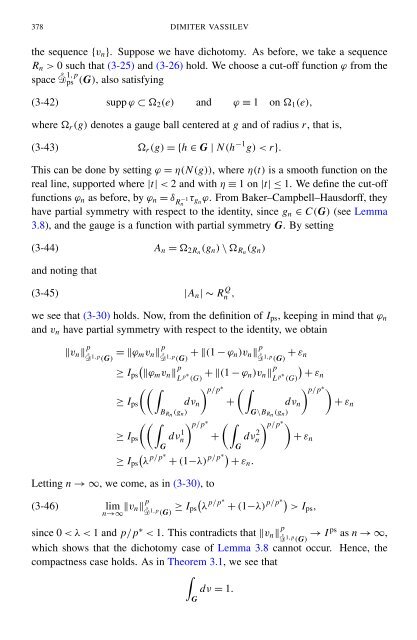Regularity near the characteristic boundary for sub-laplacian operators
Regularity near the characteristic boundary for sub-laplacian operators
Regularity near the characteristic boundary for sub-laplacian operators
Create successful ePaper yourself
Turn your PDF publications into a flip-book with our unique Google optimized e-Paper software.
378 DIMITER VASSILEV<br />
<strong>the</strong> sequence {v n }. Suppose we have dichotomy. As be<strong>for</strong>e, we take a sequence<br />
R n > 0 such that (3-25) and (3-26) hold. We choose a cut-off function ϕ from <strong>the</strong><br />
space ˚1,p ps (G), also satisfying<br />
(3-42) supp ϕ ⊂ 2 (e) and ϕ ≡ 1 on 1 (e),<br />
where r (g) denotes a gauge ball centered at g and of radius r, that is,<br />
(3-43) r (g) = {h ∈ G | N(h −1 g) < r}.<br />
This can be done by setting ϕ = η(N(g)), where η(t) is a smooth function on <strong>the</strong><br />
real line, supported where |t| < 2 and with η ≡ 1 on |t| ≤ 1. We define <strong>the</strong> cut-off<br />
functions ϕ n as be<strong>for</strong>e, by ϕ n = δ R<br />
−1 τ g n n<br />
ϕ. From Baker–Campbell–Hausdorff, <strong>the</strong>y<br />
have partial symmetry with respect to <strong>the</strong> identity, since g n ∈ C(G) (see Lemma<br />
3.8), and <strong>the</strong> gauge is a function with partial symmetry G. By setting<br />
(3-44) A n = 2Rn (g n ) \ Rn (g n )<br />
and noting that<br />
(3-45) |A n | ∼ R Q n ,<br />
we see that (3-30) holds. Now, from <strong>the</strong> definition of I ps , keeping in mind that ϕ n<br />
and v n have partial symmetry with respect to <strong>the</strong> identity, we obtain<br />
‖v n ‖ p˚1,p (G) = ‖ϕ mv n ‖ p˚1,p (G) + ‖(1 − ϕ n)v n ‖ p˚1,p (G) + ε n<br />
(<br />
≥ I ps ‖ϕm v n ‖ p L p∗ (G) + ‖(1 − ϕ n)v n ‖ p L (G))<br />
+ εn<br />
p∗<br />
((∫ ) p/p ∗ (∫<br />
≥ I ps dν n +<br />
B Rn (g n )<br />
≥ I ps<br />
((∫<br />
dνn<br />
1<br />
G<br />
) p/p ∗<br />
(∫<br />
+ dνn<br />
2<br />
G<br />
≥ I ps<br />
(<br />
λ<br />
p/p ∗ + (1−λ) p/p∗ )<br />
+ εn .<br />
) p/p ∗)<br />
dν n + ε n<br />
G\B Rn (g n )<br />
) p/p ∗)<br />
+ ε n<br />
Letting n → ∞, we come, as in (3-30), to<br />
(3-46) lim ‖v n‖ p˚1,p ≥ I ( )<br />
n→∞ (G)<br />
ps λ<br />
p/p ∗ + (1−λ) p/p∗ > Ips ,<br />
since 0 < λ < 1 and p/p ∗ < 1. This contradicts that ‖v n ‖ p˚1,p → I ps as n → ∞,<br />
(G)<br />
which shows that <strong>the</strong> dichotomy case of Lemma 3.8 cannot occur. Hence, <strong>the</strong><br />
compactness case holds. As in Theorem 3.1, we see that<br />
∫<br />
dν = 1.<br />
G
















